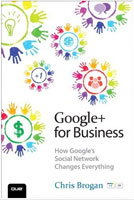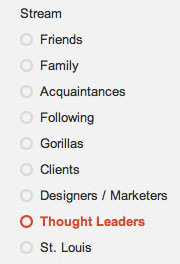 Let me begin by saying that I’m no Google+ expert. In fact, I’m a rookie. That’s why this blog post is a book review and not a lesson from Joe Sullivan on how to succeed on this platform. I read Google+ for Business, by Chris Brogan to jumpstart my own experimentation in this relatively new social network and I’m writing this post to share my biggest takeaways.
Let me begin by saying that I’m no Google+ expert. In fact, I’m a rookie. That’s why this blog post is a book review and not a lesson from Joe Sullivan on how to succeed on this platform. I read Google+ for Business, by Chris Brogan to jumpstart my own experimentation in this relatively new social network and I’m writing this post to share my biggest takeaways.
Though Google+ for Business provides a good intro to how the platform works and its basic features, I found that the value of the book is less about technicalities and more about applying business knowledge in a way that will make this social network a valuable tool for you. That said, it’s a good read both for those who want to learn how to physically use the platform as well as those who are looking for more strategic applications.
Here are the four most important things I walked away with:
Google+ presents a big opportunity for SEO and findability
Google indexes the content posted on Google+. Google never had access to the content posted in Facebook, and though they once had an agreement with Twitter that allowed Tweets to show up in search results, that agreement no longer exists. What’s posted on Google+, however, is different. Google owns this new social network and it’s sure to use the content posted there to serve up better results when people are looking for something in their search engine.

To take it a step further, when someone follows you on Google+, your content is more likely to show up in their Google searches. Why? Again, Google wants to show people the most relevant search results, and since that person has chosen to follow you, they’ve essentially already told Google that they’re interested in you or your busienss. So Google listens and responds accordingly.
Use Google+ to target and segment
 The interface is strongly focused around the ability to segment both your audience and who you’re listening to. When you post something, you can choose who sees it by organizing your connections into “Circles”. What you share with one prospective client base might be different from what you share with another. What you share with your family or friends might be different than what you share with any prospective client base.
The interface is strongly focused around the ability to segment both your audience and who you’re listening to. When you post something, you can choose who sees it by organizing your connections into “Circles”. What you share with one prospective client base might be different from what you share with another. What you share with your family or friends might be different than what you share with any prospective client base.
Similarly, you can (and should) segment those you follow. Create a circle of journalists. Read what they’re posting and get in the habit of commenting. Build relationships with them. Create a circle of competitors and keep an eye on what they’re doing. Create a circle of prospective clients. Observe what they’re talking about. Build relationships before you have the opportunity to sell to them.
Share and comment. Results will follow.
Comment on what other people are saying and offer interesting opinions on the matter. You would do that in real life conversations, wouldn’t you? So why not do it here?

Look for interesting things to share with your audience that will bring value to them. Actively seek out content that they will appreciate reading. Brogan emphasizes the importance of putting a system in place for sharing. Set up a RSS reader like Google Reader and subscribe to relevant blogs. Or at least make a list of websites that produce content of value to your audience. Check them out daily and see what you can find to share.
To be successful, you need to schedule time in your day for reading, finding info, sharing and commenting. Once you’ve made a habit out of being active, people will begin looking to you as a good source for information. The content you post doesn’t have to be yours. In fact, only some of it should be. The point is that you’ve become a curator of valuable stuff for your audience.
Be a real person. People buy from people they like.
This was the most valuable takeaway for me. It’s a an obvious truth in business, but I think it’s easy to overlook this one when you get caught up in a shiny new tool like G+.
Brogan says, “People want to follow your interests, not just your company updates.” Think about conversations you have in real life, and put yourself in that mind set. Your interactions with people on Google+ (and really any social network) should mimic them.
Brogan encourages sharing not just business-related content, but bits of personal things too. He poses the question, “Do you prefer buying from someone pushing a sales agenda, or do you prefer buying from someone you feel understands you and you feel you understand? Several reports and studies over the years boil down to the same thing: We buy from people we like.” This doesn’t mean that you have to post pics of your family vacations. It means allowing your audience to see that you have real human interests.
Find creative ways and unexpected ways to show you’re an interesting person. Give your audience a window into what happens behind the scenes at your company. Post photos and if possible, videos. Share some of the process in your work, rather than just case studies or end results. Depending on your business, try out the live group video chat feature –Hangouts. I’ve been helping my sister launch her pastry chef business over the past month. Think how engaging a live webinar-style Hangout might be for her audience. “Watch and learn and I prepare the world’s best German chocolate cake.” What’s the equivalent of that for your business?
In conclusion…
However you choose to use Google+, think of it as an extension of how you do business already. Engage with people like you would in real life and you’ll figure out how to make it a successful tool for you.
Like many, I’m in the learning and experimenting phase with this platform. I’d love to hear how you’re using Google+, successes and failures you’ve seen, as well as any ideas. Please comment below. Or, uhh, comment on my Google+ page.